A common question that usually comes to one’s mind who is eager and willing to enter into the world of Data Science, Machine Learning and Artificial Intelligence is always about the possible set of differences between all of these seemingly related terms! What sets apart a Data Scientist with a Machine Learning Engineer and how are they related or different from someone who specializes in Artificial Intelligence?
We had a detailed discussion on the differences between a Data Scientist and an AI engineer earlier and now, in this article, let’s understand how different are the skills, the job roles and responsibilities of an ML Engineer from a Data Scientist.
What is Data Science?
Data Science is an inter-related set of tasks of getting actionable insights from various form of data. It is a stack of tasks such as – data gathering, data handling, data manipulations, data insights, data visualization, and statistical analysis, Applied Statistics, Machine Learning, Deep Learning and AI. Data Science can be seen as an umbrella-term for all the activities performed on all forms of data – whether it is structured and unstructured, small or humongous. And it is a place where domain knowledge and scientific methods come together to enhance and improve the business.
What is Machine Learning?
Machine Learning is a subset of artificial intelligence where various computer algorithms are used to perform a task automatically based on inputs and data. What makes them so different from a regular algorithm is that these algorithms have an ability to improvise themselves and hence, finally improving the results. Machine Learning algorithms are able to work on the initial input data called the “training data” and build a mathematical model out of it – which enables them to perform various tasks like predictions or take decisions, without any coding intervention and explicit programming.
How are they related?
Machine Learning is a part of the Data Science stack and those algorithms are used alternatively with traditional algorithms. If we look at the stack, we see many processes inside of it which deals with data pre-processing which is an inevitable task that needs to be done for Statistical Analysis; but Machine Learning on the other hand doesn’t demand any elaborate data preparation or clean data for it to start processing.
On the surface, it mostly seems like Data Science and Machine Learning are synonymous to each other, given their common goals of extracting insights from data, but on the contrary, if one looks deeper, they are two completely different terms and Machine Learning is considered as a part of Data Science, not a synonym to Data Science.
Machine Learning Engineer vs. Data Scientist
As pointed out, the major difference between Data Science and Machine Learning lies in the set of tasks performed as a part of each process. Data Science contains a long list of tasks and tasks like predictions from the past data is a subset of this list of tasks and machine learning on the other hand absolutely deals with predictions only. One way to see the difference is that the end output of the Machine Learning algorithm is by and for a computer, whereas the output from a Data Science stack is meant to be understood by humans. Keeping in mind the differences between the underlying methodologies in the two fields of study, let’s try to understand the difference between the roles and responsibilities of someone who is designated as a Data Scientist vs a Machine Learning Engineer.
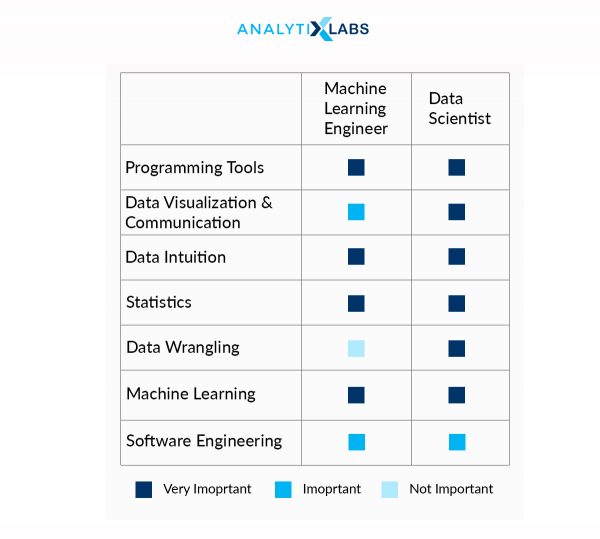
Who is a Data Scientist?
In 2012, Harvard Business Review termed Data Scientist as “the Sexiest Job of 21st Century”. A Data Scientist is someone who can prepare and analyze data to get past trends and also can get insights into the future with the help of various statistical methods and predictive modeling techniques. And amidst all the data insight tasks, a data scientist is also performing tasks that handle data that are not only incredibly large but also can be highly unstructured.
Once the insights are extracted from various tools in the data science stack, a Data Scientist has the ability to explain the results from a business perspective, identify trends, test any hunches from them and find patterns, and finally make a decision that can impact the way a business process is conducted.
A Data Scientist is a professional who works with both the world of Computer Science/IT and the business realm and hence both computer proficiency, as well as sound domain knowledge, is highly essential for a Data Scientist.
Who is a Machine Learning Engineer?
Machine Learning Engineers, unlike Data Scientists, have a narrower set of tasks – and these tasks focus on frameworks and methodologies of applying various Machine Learning algorithms on a given data for making different predictions. Working alongside the Data Scientists, the task of an ML Engineer is to run self-executing algorithms and then scale that to larger data sets and obtain results that are later passed on to the other stack of Data Science works.
A high level of programming proficiency is expected from an ML Engineer and their expertise is widely used in the fields of Image and Speech Recognition, Fraud Detection activities, Recommendation Engines etc.
The way Data Science and ML are positioned as well as overlapped with each other, an exactly similar fashion the job roles of Machine Learning Engineer vs. Data Scientist differ as well as relationships with each other.
In the coming section, let’s dig deep into the differences and hence know the spectrum of requirements so that it becomes clear to take call for someone who wishes to undergo a training in this field – whether to go for pure Machine Learning concepts or whether to go for the entire Data Science stack with Data Engineering and Machine Learning and Artificial Intelligence.
Overview
| Data Science Jobs | Machine Learning Jobs | |
| Overview | Get actionable insights from various unknown sources of data and represent the findings in a lucid, human-understandable format | Perform predictions and forecasting from historical data using various mathematical models and algorithms with increased accuracy. |
| Data | Deals mostly with data that is structured but can have unstructured and huge data. | Input data can be either structured or unstructured which may be transformed to suit a certain algorithm. |
| Common Problems | Major problems arise with the unavailability of data, where data collection is required, and it is one of the important job roles | The algorithm’s complexity and it’s scalability is of major concern. Hence strong know-how of them like tuning parameters etc. is a must-have. |
| Top Skills |
1. Statistical Tools like R, Python, SAS etc. 2. Data handling and data collection – SQL/ETL 3. Domain Expertise |
1. Statistical Tools – R, Python etc. 2. Strong software background and statistical skills. 3. Algorithm deployment, Scaling on cloud, optimization etc. |
| Outputs | Output must be in a human-understandable format and it can be a model, data, graphical representation etc. | The output from an ML algorithm is usually fed into the system again for further learning; hence it needs to be in a computer understandable format. |
| Reporting | Strong knowledge of visualization tools essential. Communicating the end results with clients and stakeholders is one of the most important aspects of Data Science | Visualization and Reporting is not essentially a component of Machine Learning but making use of native visualization libraries and showing basic insights always adds a great value. |
Related: Data Science vs Machine Learning vs AI Deep Learning
Understanding a Data Scientist
Data Scientist Tasks at a Glance
As discussed earlier, Data Science is a spectrum of tasks and they are related to a mixed field of study. So, a Data Scientist needs to have a wide variety of skillset. They make use of their statistical, mathematical, analytical and programming skills to develop data-driven solutions to various business problems. Data scientists typically have a Graduate degree in Statistics, Mathematics or Computer Science, or Economics and they are required to have a wide range of core competencies – statistics and ML, programming languages, databases, and reporting tools like MS Excel, Tableau, Power BI etc.
Job Roles and Skills Required
The foremost skill that is required for an aspiring Data Scientist is strong expertise in using Statistical Programming languages like R, Python, SAS, or SPSS and the likes. This skill is considered as the most primary requirement and it is needed to perform various data manipulations, data preparations, etc. Along with that, they can leverage these tools to perform Statically Analysis and Machine Learning tasks. Tools like SAS and R have excellent Visualization features and hence they can be used for reporting as well. Python on the other hand can be used to build an end-to-end solution. In recent times, there has been an increased demand in Python and also, a major chunk of companies use R.
Data Science job requirements need a person to have a sound knowledge of data gathering and data manipulations. Hence, data tools like DBMS, data architecture, ETL tools, etc. are the most sought out skill in this part. They’re widely used to store and fetch data, create views and data insights, and further help in attaining Business Intelligence. However, that being said, if one looks into the spread of ETL tool requirements in various job postings, it is not limited to a DBMS tool, it is of course required to have a good know-how of Big Data tools like Hadoop, distributed technologies like Map/Reduce, Hive, Spark, Gurobi, etc. and cloud-based tools like Informatica, Azure, Talend, etc.
For targeting for jobs as a Data Scientist, one must have a good command of Statistical Techniques like sampling, distributions, statistical tests, and regression problems. The immediate follow-up requirement here of course is Machine Learning algorithms. This is used to perform various tasks such as Predictions, Classification, Clustering, Forecasting, Optimization, and other related processes.
Some of the data related tasks require data to be fetched from remote sources as well. Hence a fundamental knowledge and even better, some experience in web services viz., Spark, DigitalOcean, Redshift etc. is desirable.
The Data Science process stack requires us to have reporting and visualizations at every corner and bend, so an aspiring Data Scientist needs to know Data Visualization and Analytics tools such as MS Excel, Tableau, Power BI, Grafna, Chartist and D3.js, etc.
A bird’s eye view of the job responsibilities of a Data Scientist looks like below:
- Data fetching, data gathering and data storage and accessing, dealing with unstructured data, and preparing them for getting insights.
- Strong domain knowledge and heuristic approach to problem-solving – eventually identifying and planning the correct approach to solve a business problem using scientific and statistical methods.
- Using various analytics methodologies viz., Applied Statistics, Machine Learning vs. Deep Learning, and other Methods to Solve a Business Problem.
- Validating and Optimizing the Business Solutions and taking various preemptive measures to prevent any recurring problems.
- Effectively communicating the outputs from various methodologies with the clients and stakeholders and end-users via either visualization tools or by creating an interactive Data Driven-application.
A summary of skill requirements for a Data Scientist:
- Statistical Programming languages – R, Python, SAS, etc. and expertise in programming languages like Python, Java, web languages, etc.
- Analytical and visualization tools like MS Excel, Tableau, Power BI etc
- DataBase skills and data handling tasks, understanding distributed databases, distributed computing tools like Hadoop, Spark etc., and ETL tools.
- Statistical analysis techniques like sampling, distributions, and Statistical Tests and Applied Statistics methods like Linear Regression, Logistic Regression, and Time Series Forecasting, etc.
- Machine Learning Algorithms for Regression, Classification, Segmentation, Forecasting, Optimization, and Recommendation Engines etc.
- Prior experience in the above skillsets is an added benefit.
Salary of a Data Scientist
There is an increased demand for Data Scientists and that is driving many organizations to add Data Scientists to their workforce. In this section, let’s see a glimpse of the global trend in the salaries of a Data Scientist – although a detailed salary report can be downloaded from this link.
According to payscale.com, the average salary of a DS in India is around INR 7,00,000 (USD 9,000) per year and moving up the ladder, the salary grows to around INR 11,00,000 per annum which is close to USD 14,500, and higher-level salary is around INR 18,00,000 to INR 24,00,000 pa (USD 23,000-32,000).
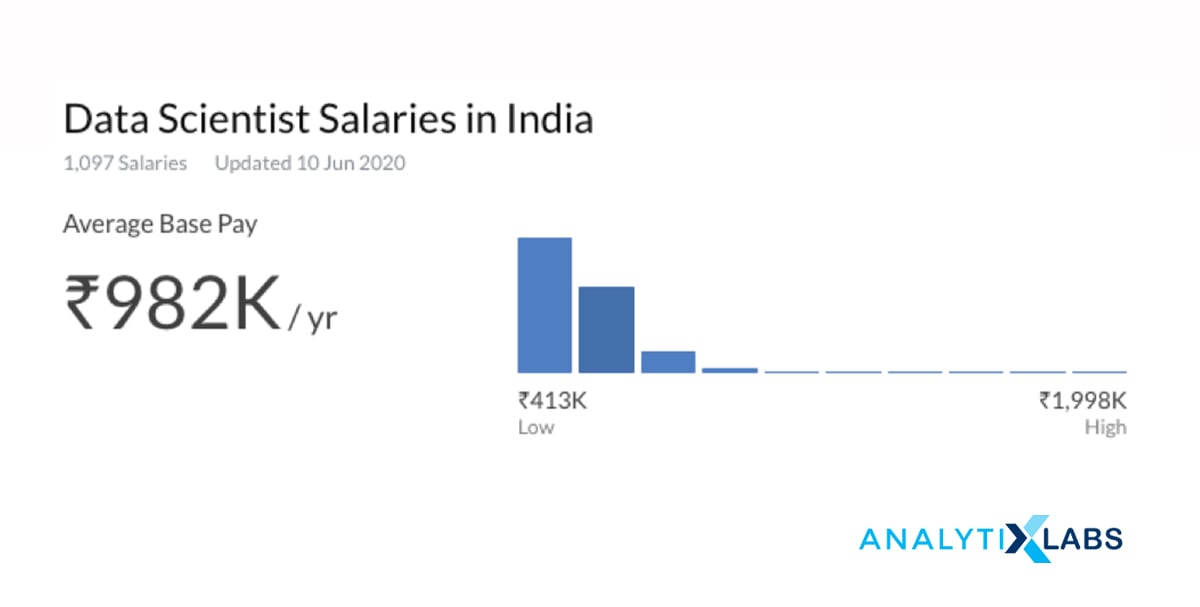
Indeed.com pegs the median salary of Data Scientist in India at a slight high of INR 8,00,000 per annum and goes as high as INR 21,00,000 per year. (USD 10,000 – 30,000). Data Science vs. Machine Learning salary and other salaries in the individual job roles in the Data Science stack might be a little different, but it cannot be ignored that the Data Scientist job role happens to be one of the most sought-out positions in recent times.
Demand and Recent Trends
In the recent times, Data Science and Data Analytics are one of the most important technological advancement that every type of business, irrespective of the domain, is striving towards hiring more talent in Data Science and the demand for Data Scientists have increased a lot since 2016 onwards. IBM predicts an increase of whooping 28% in the domains of Insurance, Finance, Professional Services, and IT and there will be close to 7,00,000 openings in various processes of Data Science stack by end of 2020.
According to Wharton, since 2017, not only the top tier companies but also mid to small level companies have started to hire for this position from sectors like manufacturing, marketing, digital marketing, education and consulting, etc. Data Science job requests mostly comprise of Research, Statistics, Machine Learning, Neural Networks, Recommendation, Optimization, Prediction and Natural Language Processing.
Related: How to Become a Data Scientist – A Step By Step Guide
Understanding a Machine Learning Engineer
Machine Learning Tasks at a Glance
Just like a Data Scientist, an aspiring ML engineer too requires strong expertise in using Statistical Programming languages. R and Python respectively provide R packages and Python packages that contain robust implementations of Machine Learning algorithms within their ecosystem. All of these algorithms are easy to use and implement and their outputs can be passed on to a Data Scientist for further analysis.
Job Roles and Skills Required
The primary skill required for a Machine Learning Engineer is to have sound knowledge in statistical languages like R, Python, etc. Statistical tools are the tools that are of primary requirements to handle any data manipulation related tasks and later to design and implement a machine learning algorithm on that data. R is a language that is built for machine learning and Python is made up of robust and easy to use libraries that implement the machine learning algorithms. R has remained a tool of choice for many companies who strive to implement applied statistics and machine learning technologies, especially with the cross-domain, management consulting companies and Python is an emerging tool in this domain if the end goal is moving towards advanced Deep Learning.
This knowledge of tools is followed up and reinforced by having a good command of Statistical Techniques like sampling, distributions, statistical tests, and regression problems. Also, an ML Engineer should understand various business problems and their statistical and machine learning solutions, just like we have seen in the case of a Data Scientist’s job requirements. However, one major point of difference here is that an ML engineer needs to scale all the theoretical models defined by Data Scientists to real-time data and get results accordingly.
Now, the next requirement is actually the titular one for the job role of machine learning engineer, and that is – machine learning algorithms and concepts. One requires to know algorithms like:
- Linear Regression
- Logistic regression
- k-means clustering
- Discriminant Analysis
- Principal Component and Factor Analysis
- Classification and Regression Trees
- K-Nearest Neighbors
- Naïve Bayes
- Support Vector Machines
- Ensemble Learning, etc.
Added to the above list, an aspiring ML Engineer should have strong adroitness in one or either of domains like Natural Language Processing, Fraud Detection, Robotics, Image Recognition, Speech Recognition, etc.
A machine learning engineer is still bound to some of the larger Data Science stack tasks. Hence, they must collaborate and work on various codebases and coordinate with different teams that work on the Data Science stack. Hence, it is required to have a fundamental know-how of the best practices in coding collaborations. The outputs scheme should be carefully designed and calibrated so that the collaborations become easy.
The above-mentioned skills are mostly the essential skills for machine learning in data science but given the requirements and competitiveness, there are some minor good-to-have add-ons for a Machine Learning Engineer like distributed computing, Spark/Hadoop, Github and Docker, designing and implementing custom code as opposed to using pre-defined libraries from R or Python. Coding collaborations and other data sharing tasks can become much easier with a basic knowledge of distributed systems, Spark, Hadoop etc.
Organizations looking for a Machine Learning Engineer expect their workforce to perform the following common tasks:
- Study and scale theoretical Data Science paradigms and prototypes and eventually design Machine Learning systems.
- Understand the Business Problem from a scientific perspective and device methods to solve the same using a suitable and optimal Machine Learning algorithm.
- Select appropriate and necessary data sets for implementation and later design suitable methods to represent the data.
- Perform various Machine Learning tests and experiments and strive to improve and enhance existing solutions.
- Perform statistical analysis – hypothesis testing and fine-tune the end results.
- Train and retrain systems wherever required.
- Provide technical knowledge to support engineers, product managers and Data Scientists to ensure and maintain post-implementation efficiency of Machine Learning solution and improvise on the system wherever necessary.
A quick sneak peek of the requirements for a Machine Learning Engineer are:
- Mandatory expertise and experience in programming languages like Python, Java, C/C++ and end-to-end application development using web technologies etc.
- Statistical Programming languages – R, Python, SAS etc. Analytical and visualization tools like MS Excel, Tableau, Power BI etc.
- Data Base skills and data handling tasks using any of the statistical tools.
- Strong expertise in Machine Learning Algorithms for Regression, Classification, Segmentation, Forecasting, Optimization, and Recommendation Engines etc.
- Statistical analysis techniques like sampling, distributions, and Stats Tests and Applied Statistics methods like Linear Regression, Logistic Regression, and Time Series Forecasting etc. are a good add-on.
- Knowledge of Hadoop, Spark, Spark ML, Kafka etc. are a good add-on.
Salary of a Machine Learning Engineer
In the Data Science stack, one of the most crucial processes is Statistical Analysis of the data, in which Applied Statistics and Machine Learning are the two underlying processes. Hence, it’s more than natural that there is in fact huge importance of Machine Learning Engineer.
A Machine Learning Engineer in India has an average salary ranging from INR 6,00,000 – 7,50,000, depending on the hiring organization, position, and experience of the applicant, according to Glassdoor, Payscale and Linkedin.
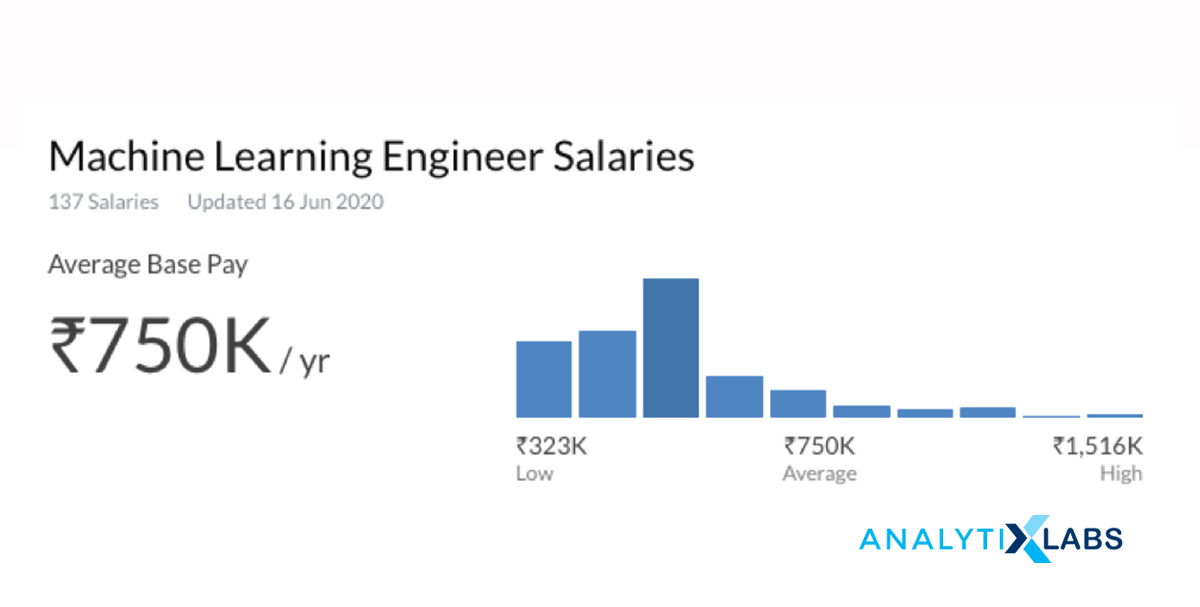
According to LinkedIn, Python is the most popular and tool of choice for a Machine Learning Engineer in India and globally, followed by R. Natural Language Processing is one of the most sought out as well as well-paid skills for Machine Learning jobs. Although there is a considerable difference in the Machine Learning vs. Data Science salaries, it cannot be brushed off that Machine Learning is one of the most important job roles to look out for technically experienced people like Software Engineers, Network Programmers, and Analysts, etc.
Related: An Ultimate Guide to Starting a Career in Machine Learning
Demand and Recent Trends
In the previous section, we have seen how companies are aggressively switching into data-driven analysis and decision making, hence making Data Scientists the most sought out job hiring done by big and small companies alike. And added to that, we have also seen that Machine Learning is the most sought out skill in the Data Science stack. Hence, there is a massive demand for Machine Learning Engineers and it can be easily seen that this demand actually surpasses the requirements for Data Scientists all together.
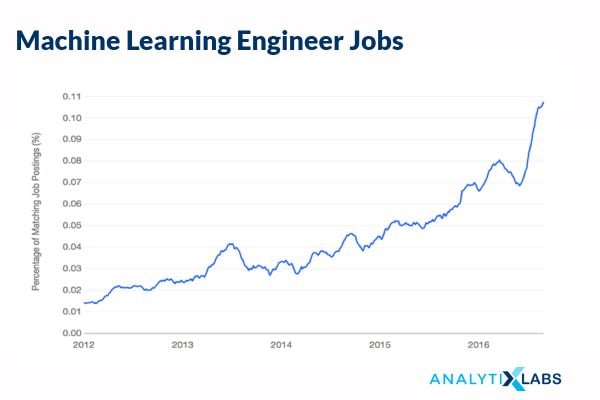
According to Indeed, Machine Learning Engineer is one of the best jobs and most requested job in 2019-20 with a salary growth rate of more than 300%. Some of the important skills sought out in the jobs are supervised/unsupervised learning, reinforcement learning, regression, semi-supervised learning etc. There has been a 20% increase in the machine learning job postings in the month of April-May 2020 and this trend is set to continue till 2022.
Summary
Data Science, as often known and mentioned, is a broader term for multiple processes and Machine Learning is one of the major parts of it. Machine Learning demands strong programming skills and understanding of algorithms, whereas, Data Science on the other hand requires strong analytical, statistical skills, combined by domain science and decision making. Hence, someone who is a beginner to the job world or has minor but relevant experience in Software Engineering can rightfully undergo professional training in Machine Learning algorithms and simultaneously develop data handling skills and target for Machine Learning jobs.
Experienced job seekers with prior experience in Data Handling, problem-solving expertise, business executives, etc. can get trained with various Data Science tools like Statistical Tools, ETL tools, and Visualization tools, etc., and then target for various levels of Data Scientist job roles. Text Handling, Natural Language Processing, and Text Mining are some of the strongest skills that an aspirant can have for both Machine Learning and Data Scientist Roles.
You may also like to read:
1. Data Scientist vs Artificial Intelligence Engineer – What is the difference?
2. Data Science vs. Computer Science; Skills & Career Opportunities

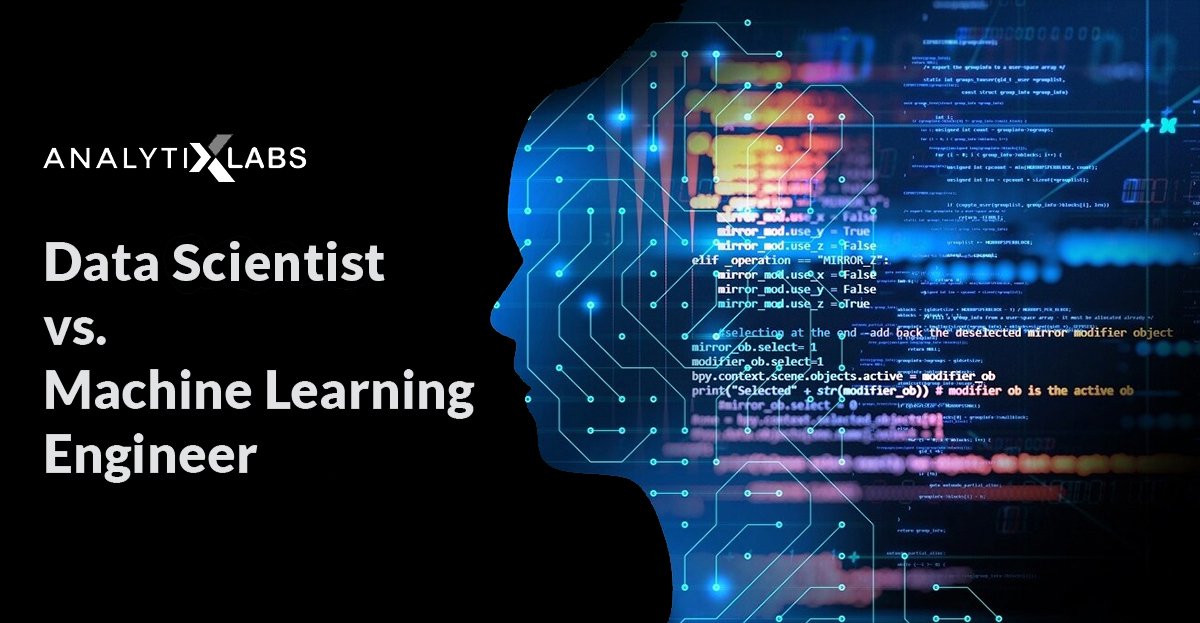


![Tree Traversal in Data Structure Using Python [with Codes] tree traversal in data structure](https://www.analytixlabs.co.in/blog/wp-content/uploads/2025/01/Cover-Image-1-370x245.jpg)



